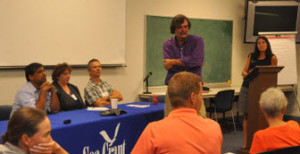 A seminar series by Sea Grant in the Gulf of Mexico (Navigating Shifting Sands: Oil on our Beaches) was held on August 5, 2015, in Pensacola, FL. Scientists shared their work to answer lingering questions about oil that washed up on Alabama and Florida beaches during the Deepwater Horizon oil spill. More than 85 participants attended this seminar in person or through webinar.
A seminar series by Sea Grant in the Gulf of Mexico (Navigating Shifting Sands: Oil on our Beaches) was held on August 5, 2015, in Pensacola, FL. Scientists shared their work to answer lingering questions about oil that washed up on Alabama and Florida beaches during the Deepwater Horizon oil spill. More than 85 participants attended this seminar in person or through webinar.
To view video and PowerPoint presentations from the 11 Speakers at the Seminar CLICK HERE
Speakers included:
Introduction to the Oil Spill Science Outreach Program
Larissa Graham is an Extension Specialist with Mississippi-Alabama Sea Grant. She facilitated the “Navigating Shifting Sands: Oil on our beaches” seminar and provided an overview of the Oil Spill Science Outreach Program.
Extent and Degree of Shoreline Oiling: Deepwater Horizon Oil Spill
Scott Zengel is a Senior Scientist with Research Planning, Inc. (RPI). Scott served as one of the NOAA shoreline assessment leads during the Deepwater Horizon oil spill, and continues to support the Natural Resource Damage Assessment (NRDA) and restoration planning efforts. He will be speaking about shoreline oiling as documented by the Shoreline Cleanup Assessment Technique (SCAT) program.
Alabama and Florida beaches and the Deepwater Horizon oil spill
Dr. Joel Hayworth is an associate professor at Auburn University. His work focuses on assessment and restoration of human-impacted natural systems. He will be talking about the broad impacts of the oil spill on Alabama and Florida nearshore and beach systems.
Sand and Oil Agglomerates in the Surf Zone: Using Science to Aid Deepwater Horizon Clean-up Efforts
Dr. Soupy Dalyander is a research oceanographer with the U.S. Geological Survey at the St. Petersburg Coastal and Marine Science Center. She studies sediment transport and geomorphological change on the beach, nearshore, and continental shelf. She will be talking about the physical dynamics of sand and oil agglomerates (essentially “sinking tar balls”), which can form when oil mixes with sediment in shallow water and are a potential source of beach re-oiling.
Physicochemical characteristics of Deepwater Horizon tar balls
Dr. Prabhakar Clement is a professor in the Environmental Engineering program at Auburn University. He has been collecting and analyzing Deepwater Horizon (DWH) oil spill tar balls for the past five years. Prabhakar is an expert in fingerprinting, identifying, and characterizing oil spill residues. He will present a field dataset to demonstrate increases in background oil contamination along Alabama’s beaches. He will also discuss the fate of some toxic polycyclic aromatic hydrocarbons trapped in DWH tar balls.
Marine tar residues: What we’ve learned from the Deepwater Horizon Spill
Dr. Patricia Sobecky is a professor and an associate provost at the University of Alabama. She is a microbiologist with expertise in marine microbiology. She’s conducted microbiology studies in the Gulf of Mexico deep sea and coastal habitats. She will be talking about the microbiology of marine tar residues (tar balls, tar mats) and their impacts on coastal ecosystems.
The fate of oil buried in Pensacola Beach sands
Dr. Markus Huettel is a professor at Florida State University. He is a coastal oceanographer and his research focuses on biogeochemical processes in marine sediments and the exchange processes between the seafloor and overlying water column. Markus will be talking about the degradation of buried Deepwater Horizon oil in Florida sandy beaches.
